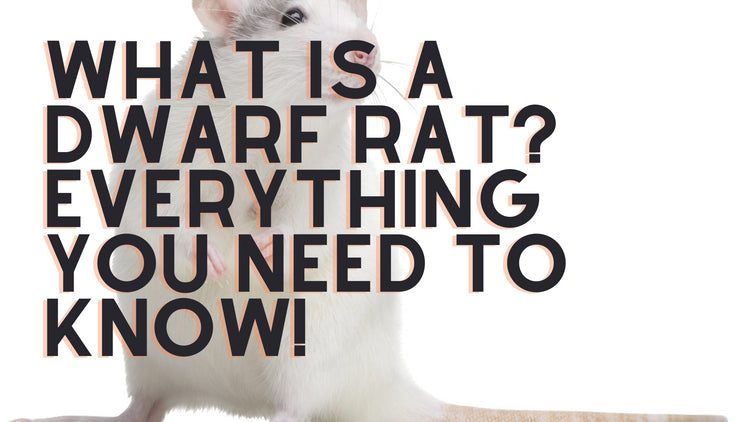If you’ve been looking for a tiny pet to add to the family, then you may have stumbled across dwarf rats in your research. But what is a dwarf rat? Is it just another name for a small rat? And are dwarf rats even good pets? In this guide, we’ll tell you everything you need to know about dwarf rats to help you learn about these tiny, adorable creatures, and maybe even figure out if they are the right fit for your family.
Let’s get to it! What Is a Dwarf Rat?
We’ll begin by clearing up a common misconception: no, dwarf rats are not just small rats. And while they’re often confused with them, they’re not closely related to mice, either.
The difference between dwarf rats and these other small rodents lies in their genes. These tiny rats possess and display a recessive gene that prevents them from producing the same amount of growth hormones as their full-size counterparts. In fact, they produce roughly 90-94% less!
Without these additional hormones, it’s no wonder that dwarf rats are unable to get as big as your typical rat. How Big Do Dwarf Rats Get?
Though they do carry the same dwarf gene, some dwarf rats get to be bigger than others. In fact, they are usually somewhere around 40% - 70% of the size of an average adult rat. This makes them only slightly bigger than some fancy mice, which is likely why there is often confusion between the two.
Now, unless you’re familiar with the approximate size of a standard adult rat, you may be wondering: what does this range mean in terms of the weight of a dwarf rat? Well, while a standard male rat weighs in at around 450-650g, and a standard female comes in at around 250-450g, both male and female dwarf rats only weigh between 80-125g.
As you can see, there is quite the difference here! And that’s not the only physical difference, either.
How Can You Tell the Difference Between a Small Rat and a Dwarf Rat? As with any animal, not every standard pet rat will fit into the average size range we listed above. Some will be significantly bigger, and others will be quite a bit smaller. So then, in the case of the latter, how can you tell whether it’s just the runt of a litter or a dwarf rat?
Since you can’t physically see a recessive gene, this can be tricky. However, if you look closely, there are a few ways you can tell a small standard rat apart from a dwarf rat.
When compared with standard rats, dwarf rats usually have: A shorter, thinner tail that typically doesn’t thicken at the base Smaller feet A distinct head shape Bigger eyes in relation to their body So, if you’re trying to identify a dwarf rat, you may want to put them next to a standard rat for best results. But should you really put them together?
Can Dwarf Rats Live with Normal Rats?
Absolutely! While they may have some physical differences, dwarf rats and standard rats tend to have similar temperaments, so they can get along quite well in the same cage. T
hat being said, it is a good idea to take the temperaments of the rats into consideration. If you have a standard rat with a calm, social demeanor, then you probably wouldn’t have any issue adding a dwarf rat into the mix.
However, if you have an aggressive standard rat, you may want to think twice before throwing a tiny little guy in there. You’ll need to use your best judgment here. Overall, though, there’s no reason why dwarf and standard rats can’t live together. In fact, it can be good for them both!
Can a Dwarf Rat Be Happy Alone?
Generally, no. A dwarf rat would likely be unhappy alone. Like standard rats, dwarf rats are social creatures, so we wouldn’t recommend letting a dwarf rat live by itself in a cage. If you want your dwarf rat to be happy (and as a responsible pet owner, of course you do!), then it’s important to give it some kind of companionship.
Sure, it can be difficult to find dwarf rats, but that’s why it’s nice that they get along so well with standard rats. A friend - whether it’s another dwarf rat or a standard one - to play and socialize with is key to ensuring a long and happy life for your little friend.
And while we’re on the subject, how long is the life of a dwarf rat, anyway? How Long Do Dwarf Rats Live?
You may think that their lack of growth hormones would affect their lifespan, but that’s not the case! In fact, dwarf rats can live up to three years. This is just about as long as other types of pet rats.
Interestingly, though, there is one thing about dwarf rats that may cause them to live just a bit longer than standard rats. While there are no known health issues that are caused by the recessive dwarf gene and lack of growth hormones, there does appear to be one health benefit: dwarf rats do not tend to develop the types of cancerous tumors that are often seen in standard rats. More specifically, research shows that dwarf rats are resistant to chemically induced mammary carcinogenesis.
This is great news for standard rat owners who have had to deal with this type of issue before. It’s not fun having to watch any kind of pet suffer through cancer, so it’s nice to know that this may not ever be an issue if you adopt a dwarf rat.
Now, you may not have to deal with tumors, but you do need to take care of your dwarf rat properly if you want it to live a long and happy life. Part of this means keeping a close eye on their diet and weight, as they’re so small that even a little extra food here and there can make a big difference in their size.
Let’s now take a look at how to take care of a dwarf rat.
How to Take Care of a Dwarf Rat Some good news: if you’ve ever had a pet rat before, then you are likely well-prepared to take care of a dwarf rat! They generally require the same kind of care and attention, with perhaps just a few extra details to keep in mind. Let’s take a look at how to take care of a dwarf rat.
Housing
Let’s begin by clearing up a common misconception: dwarf rats may be smaller than standard rats, but this doesn’t mean that you can just stick them in a small cage. Like their full-sized counterparts, dwarf rats can be rather active creatures, and therefore need a good amount of room to move around. This means you should avoid placing a dwarf rat in a hamster cage or anything similar. Instead, you should consider opting for a cage that’s at least 2 x 2 x 2 feet.
It should have a solid base, and be made of metal for best results. Not only should you avoid placing them in a large aquarium, as this won’t provide adequate ventilation, but you also shouldn’t put them in anything plastic.
Dwarf rats can easily chew through plastic, so unless you want to be hunting around your home for a tiny rat there’s no point in even trying this kind of material! And, if you can, it’s also a good idea to put them in a cage with multiple levels. Dwarf rats tend to be climbers, so they’ll likely appreciate this feature.
This can also help keep them more active. Once you have your cage in place, you’ll need to line it with a shredded, absorbent material. Something like wood flakes is usually a good option. You’ll then need to spot clean this lining as necessary, as replace it all at least once a week.
Food and Water Since they are so similar to standard rats, dwarf rats can do well on a typical rat diet. This means you can just feed them a commercial rat pellet food to make sure they get the right balance of nutrients in their diet. As previously mentioned, it’s a good idea to keep a close eye on how much your dwarf rat is eating due to their small size.
So, try to keep them on a twice-a-day feeding schedule; once at dusk and once at dawn. And when it is feeding time, try not to leave the food in there for longer than 30 minutes, as this will help prevent them from overeating. Don’t forget to add in the occasional treat!
Once or twice a week, you can replace a small portion of their pellet food with something healthy. For example, apples, banana, broccoli, and celery are some suitable options. Of course, you’ll also need to provide your dwarf rat with clean drinking water so it doesn’t get dehydrated. But you shouldn’t do this with a water bowl, as it can easily be knocked over or even become contaminated with other things in the cage. Instead, you should attach a water bottle to the side of the cage.
Buy a water bottle that comes with a leak proof ball, as this will help ensure that it only drips water when your dwarf rat goes to take a drink. You’ll want to check it a few times a day to make sure it’s nice and full, and clean it regularly to keep the water nice and fresh. Socializing and Play Like we mentioned before, dwarf rats are social creatures that need attention. So, in addition to giving it a friend to live with, make sure you give it some love and affection yourself everyday.
And while you have it outside of its cage, give it a short period of supervised exploring time too. This will give your dwarf rat both some extra exercise and entertainment. You should also provide your dwarf rat with a variety of toys and accessories to play with inside of their cage. Wooden chew toys, tunnels, a wheel, and climbing ropes are all good options. You may want to consider switching them up every so often so they don’t get bored.
Are Dwarf Rats Good Pets?
Now that you know more about them, it’s time for the big question: are dwarf rats good pets? And the answer is yes! Just like standard rats, dwarf rats can make great pets. They are playful, energetic, and social little creatures that enjoy human contact. In fact, some dwarf rats can be quite comfortable when they’re held by humans. Not only that, but they tend to be a bit calmer than standard rats, which makes them a great choice for both children and those looking for a lower-maintenance caged pet.
However, every dwarf rat is different. This means that some will have more affectionate and energetic personalities than others. So, if you have the opportunity, it’s a good idea to get to know your dwarf rat a little before you take it home.
Where Do You Get a Dwarf Rat?
It can be difficult to find a dwarf rat in a pet store, so you may want to look into a rattery. You will want to be careful, though, as some breeders will try and pass off a small rat as a dwarf to make more money (they tend to be more expensive).
That’s why it’s so important to do your research and adopt from a reputable breeder. You may need to be patient, though - since dwarf rats can be both high in demand and difficult to breed, you may be put on a waitlist.
Wrapping Up
If you’ve been looking for an adorable little creature to add to your family, then a dwarf rat may be right for you! Not only do they make great pets, but they don’t require any special care when compared with standard rats. They may even live longer! So, if you’re interested in picking up a dwarf rat (or, ideally, two) get out there and start looking into reputable breeders today.
Good luck!





